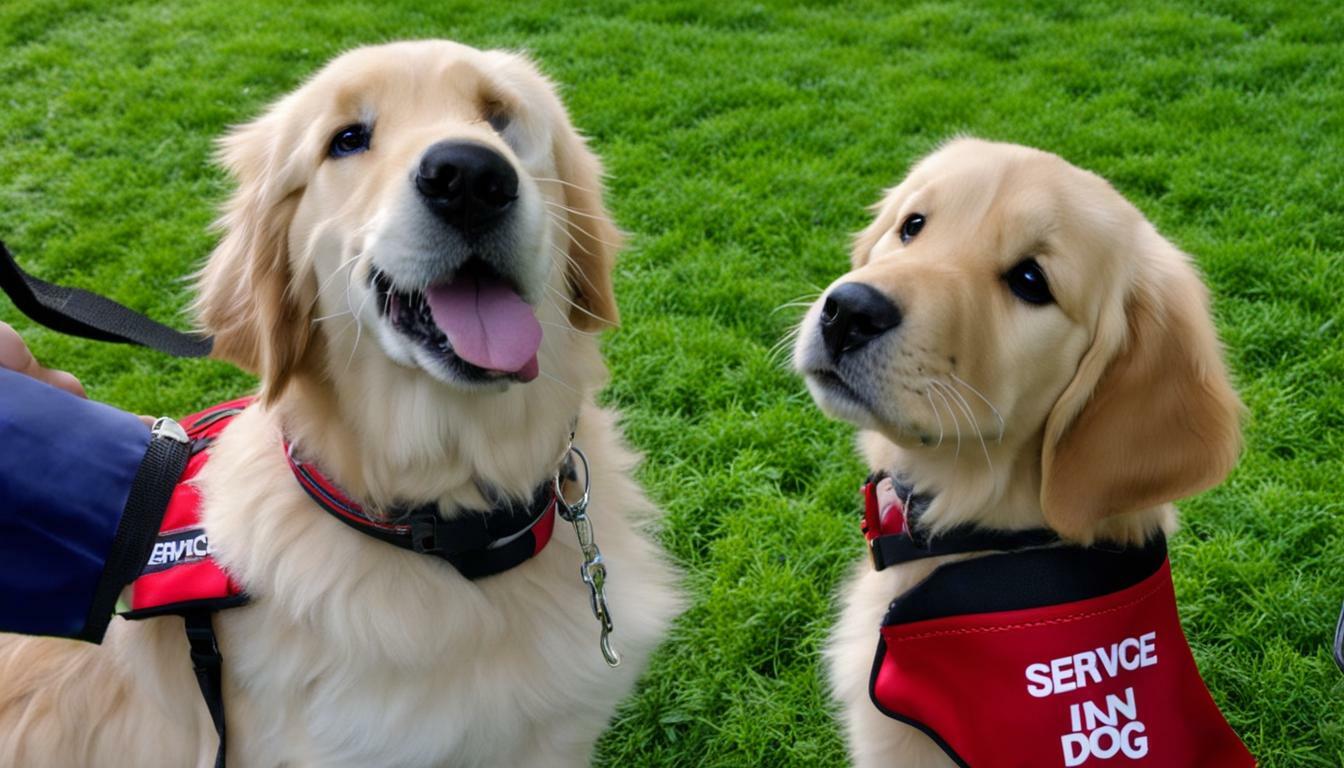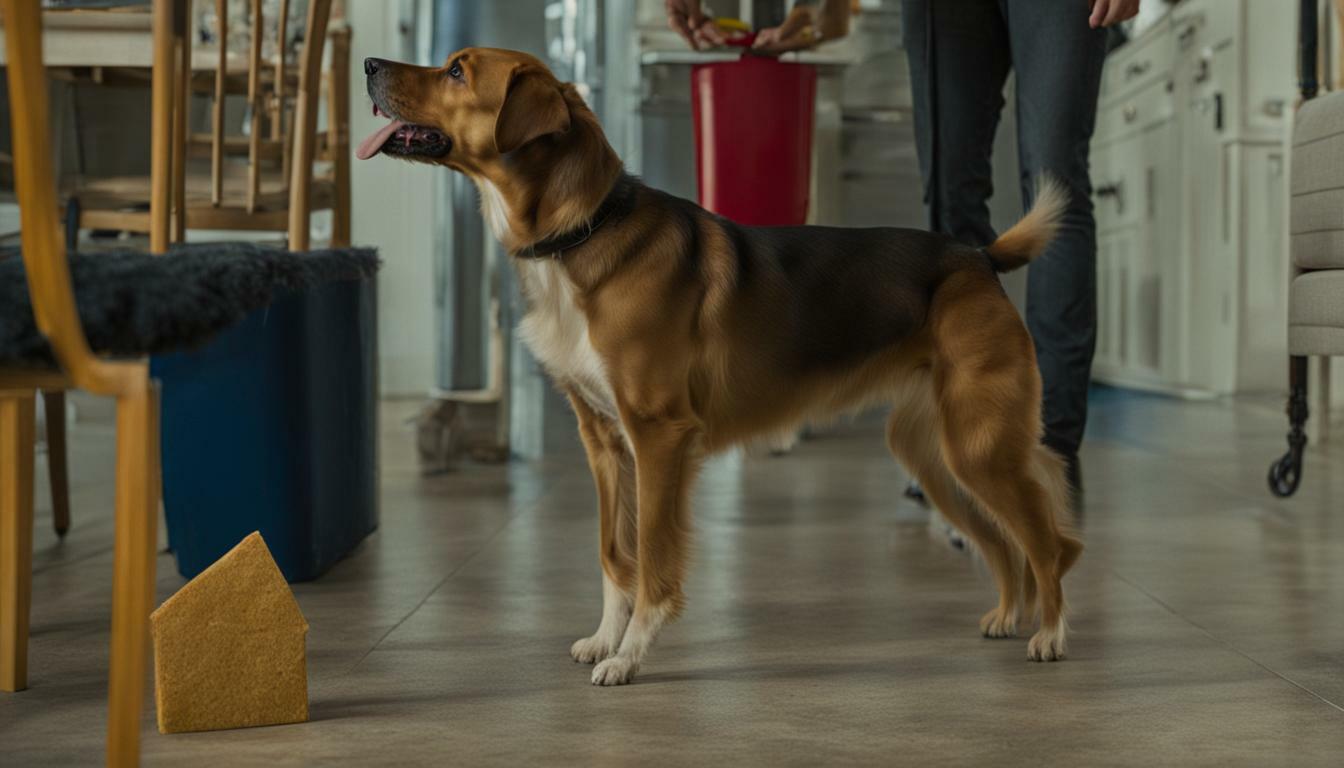Training a service dog requires a significant investment of time and patience. The duration of service dog training can vary depending on several factors, including breed, temperament, and the desired tasks the dog is being trained for. Other factors such as the dog’s age, previous training, and the chosen training method can also impact the timeline.
There are two main types of service dogs: psychiatric service dogs and dogs for physical disabilities. Popular service dog breeds include German Shepherds, Golden Retrievers, Labrador Retrievers, Poodles, Pugs, and Cocker Spaniels.
The training process typically involves several stages, including obedience training, socialization, task-specific command training, and public access skills training. Obedience training focuses on teaching the dog basic commands and good manners, while socialization exposes the dog to different environments, people, and experiences. Task-specific command training is essential for teaching the dog the specific tasks it will perform to assist its owner. Public access skills training ensures that the dog can behave appropriately and confidently in public settings.
Training a service dog can be done through either online or in-person programs. Online training programs, such as Pettable’s online psychiatric service dog training, offer the convenience of self-paced lessons and are often more affordable than in-person training.
Key Takeaways:
- Training a service dog can take anywhere from six months to two years.
- The duration of training can be influenced by factors such as breed, temperament, and desired tasks.
- Obedience training, socialization, task-specific command training, and public access skills training are all important components of service dog training.
- There are two main types of service dogs: psychiatric service dogs and dogs for physical disabilities.
- Popular service dog breeds include German Shepherds, Golden Retrievers, Labrador Retrievers, Poodles, Pugs, and Cocker Spaniels.
Factors Affecting Service Dog Training Duration
Several factors come into play when determining how long it takes to train a service dog. Breed, temperament, desired tasks, age, previous training, and the chosen training method all play a role in the timeline for training a service dog.
Firstly, the breed of the dog can impact training duration. Certain breeds, such as German Shepherds, Golden Retrievers, Labrador Retrievers, Poodles, Pugs, and Cocker Spaniels, are known for their intelligence and trainability, which can expedite the training process.
Temperament is another important factor. Dogs with a calm and focused temperament are often easier to train and may progress more quickly through the training program.
The complexity and number of desired tasks also influence the training duration. Dogs trained for physical disabilities may require a longer training period compared to psychiatric service dogs, as they need to master tasks such as retrieving objects, opening doors, and providing balance support.
| Factors Affecting Service Dog Training Duration | Timeline for Training a Service Dog |
|---|---|
| Breed | Varies, with intelligent breeds typically learning faster |
| Temperament | A calm and focused temperament can expedite the training process |
| Desired Tasks | The complexity and number of tasks affect training duration |
| Age | Starting training at a younger age can lead to faster progress |
| Previous Training | Prior training can positively or negatively impact the training timeline |
| Training Method | The chosen training approach can affect the speed of training |
In addition to these factors, the dog’s age and previous training can also influence the timeline. Starting training at a younger age can lead to faster progress, while dogs with previous training experience may require less time to learn new skills.
Lastly, the chosen training method can impact the speed of training. Online and in-person training programs are available, with online training being a more affordable and convenient option for many individuals. Pettable offers online psychiatric service dog training with self-paced lessons, allowing individuals to progress through the training at their own pace.
By considering these factors and tailoring the training program to the individual dog’s needs, trainers can work to optimize the training timeline and ensure that service dogs are well-prepared to serve their handlers.
Types of Service Dogs
Service dogs can be classified into different categories based on the specific tasks they perform and the disabilities they assist with. These highly trained canines play a crucial role in supporting individuals with various physical and mental health conditions. Let’s explore the two main types of service dogs:
1. Psychiatric Service Dogs
Psychiatric service dogs are trained to assist individuals with mental health conditions such as anxiety disorders, post-traumatic stress disorder (PTSD), depression, and autism spectrum disorders. These dogs provide emotional support, help with grounding techniques, interrupt harmful behaviors, and offer a sense of security and calmness in challenging situations. Psychiatric service dogs are trained to recognize and respond to their handler’s specific needs, providing comforting pressure during anxiety attacks, waking them up from nightmares, or guiding them to safety in crowded places.
2. Dogs for Physical Disabilities
Dogs for physical disabilities are trained to assist individuals with mobility limitations, visual impairments, and other physical disabilities. These dogs are trained to perform tasks such as opening doors, retrieving dropped items, navigating obstacles, alerting to sounds, and providing stability and balance. They are also trained to assist individuals who use wheelchairs or other mobility aids, offering support and companionship in their daily activities.
While German Shepherds, Golden Retrievers, and Labrador Retrievers are popular breeds for service dogs, other breeds such as Poodles, Pugs, and Cocker Spaniels can also excel in these roles. The breed selection depends on factors such as size, temperament, intelligence, and suitability for the specific tasks required.
| Breed | Type of Service |
|---|---|
| German Shepherd | Psychiatric Service, Physical Disabilities |
| Golden Retriever | Psychiatric Service, Physical Disabilities |
| Labrador Retriever | Psychiatric Service, Physical Disabilities |
| Poodle | Psychiatric Service, Physical Disabilities |
| Pug | Psychiatric Service, Physical Disabilities |
| Cocker Spaniel | Psychiatric Service, Physical Disabilities |
When considering a service dog, it is essential to understand the specific tasks and assistance required, as well as the temperament and characteristics of different breeds. Training a service dog is a complex and time-consuming process, but the rewards of having a well-trained companion are invaluable.
Obedience Training for Service Dogs
Obedience training forms the foundation of a well-trained service dog. This crucial aspect of training teaches the dog basic commands and behaviors to ensure they can perform their tasks effectively and safely. Whether it’s guiding individuals with visual impairments, providing stability for those with mobility challenges, or offering emotional support for individuals with psychiatric conditions, a service dog must be obedient and reliable.
During obedience training, service dogs learn essential commands like sit, stay, come, down, and heel. These commands enable them to assist their handlers in various situations, such as navigating through crowded areas, remaining calm in noisy environments, or providing emotional support during times of distress. Consistency and positive reinforcement techniques, such as rewards and praise, are key to shaping desirable behaviors and reinforcing the dog’s understanding of these commands.
It is also important to note that obedience training is not limited to the basic commands. Service dogs undergo extensive training to master advanced skills specific to their handler’s needs. This may include specialized tasks such as retrieving objects, opening doors, turning lights on and off, or alerting to medical conditions. Task-specific command training goes hand in hand with obedience training, ensuring that service dogs are proficient in both general and specialized commands.
| Benefits of Obedience Training for Service Dogs |
|---|
| • Allows service dogs to function effectively and safely in various environments |
| • Enhances the bond and communication between the service dog and handler |
| • Provides the foundation for task-specific command training |
| • Ensures public confidence and acceptance of service dogs |
Overall, obedience training is a vital component of service dog training. It lays the groundwork for a successful partnership between the service dog and their handler, allowing them to navigate the challenges of daily life and improve the quality of life for individuals with disabilities.
Socialization for Service Dogs
Socialization plays a crucial role in shaping a service dog’s behavior and responsiveness to various situations. It involves exposing the dog to different environments, people, and experiences to ensure they can confidently navigate the world and perform their tasks effectively.
During the socialization process, service dogs are introduced to various stimuli such as loud noises, crowds, different types of flooring surfaces, and other animals. This exposure helps them become acclimated to different environments, reducing the likelihood of anxiety or fear responses in real-life situations.
Service dogs also undergo socialization training to become comfortable interacting with people, including strangers. They learn to respond appropriately to greetings, remain calm when approached, and maintain focus on their handler during interactions.
Furthermore, service dogs are exposed to common scenarios they may encounter when working, such as restaurants, stores, public transportation, and medical facilities. Through this training, they learn to navigate crowded spaces, tolerate distractions, and maintain their composure in various public settings.
Table: Examples of Socialization Scenarios for Service Dogs
| Socialization Scenario | Description |
|---|---|
| Walking on Different Surfaces | Exposing the dog to various textured surfaces, including grass, gravel, hardwood floors, and stairs. |
| Interacting with Strangers | Teaching the dog to remain calm and focused when approached or greeted by unfamiliar individuals. |
| Exposure to Noises | Introducing the dog to various sounds like sirens, doorbells, vacuum cleaners, and crowds to minimize fear responses. |
| Public Transportation | Preparing the dog to navigate buses, trains, and other modes of public transportation with ease and confidence. |
By undergoing comprehensive socialization training, service dogs develop the necessary skills to adapt to their handler’s needs and come across as well-behaved and approachable in public. This training is essential in ensuring they can perform their tasks effectively and provide the support and assistance required by individuals with disabilities.
Task-Specific Command Training
Service dogs undergo specialized training to learn task-specific commands that align with their handlers’ needs. This phase of training focuses on teaching the dog specific tasks that they will perform to assist their handler, whether it’s retrieving items, opening doors, or providing emotional support. Task-specific commands are crucial for service dogs to become reliable and efficient in their roles.
During this training, service dogs are taught a range of commands and behaviors relevant to their designated tasks. For example, a psychiatric service dog may be trained to recognize signs of anxiety or panic attacks and respond by providing deep pressure therapy or grounding techniques.
To ensure successful task-specific command training, consistency and repetition are key. Handlers work closely with professional trainers who use positive reinforcement techniques to reinforce desired behaviors and discourage unwanted ones. By establishing a strong bond and clear communication with their handlers, service dogs become proficient in performing their tasks reliably and confidently.
| Task | Command |
|---|---|
| Retrieve objects | “Fetch” |
| Open doors | “Open” |
| Guide on stairs | “Step up” / “Step down” |
| Alert to sounds | “Listen” |
| Provide deep pressure therapy | “Pressure” |
It’s important to note that task-specific commands can vary depending on the individual needs of the handler and the tasks the service dog is trained to perform. The training duration for mastering specific tasks can also differ for each dog and handler pair, influenced by factors such as the dog’s learning ability, handlers’ consistency, and the complexity of the tasks. Patience and continued reinforcement are essential throughout the training process to ensure that service dogs can reliably execute their tasks when needed.
Public Access Skills Training
Service dogs must be proficient in public access skills to ensure their handlers’ safety and well-being in various environments. This type of training focuses on teaching service dogs how to behave appropriately and confidently while navigating public spaces. It involves equipping them with the necessary skills to handle distractions, obey commands, and maintain good leash manners.
During public access skills training, service dogs are exposed to different environments, such as busy streets, shopping malls, and public transportation. They are trained to remain calm and focused, despite the various stimuli they may encounter. This training also includes socialization exercises to help service dogs interact appropriately with strangers, children, and other animals they may encounter in public.
Service dogs learn to navigate through crowds, walk alongside their handlers without pulling on the leash, and respond to commands promptly. They are taught to ignore food and other distractions, stay close to their handlers, and provide assistance as needed. These skills are vital for service dogs to carry out their tasks effectively, especially in public settings where their handlers rely on their support and assistance.
| Key Aspects of Public Access Skills Training |
|---|
| Exposure to various public environments |
| Behavior around distractions and strangers |
| Good leash manners and walking alongside the handler |
| Response to commands and prompts |
| Interaction with other animals |
Online vs. In-Person Training Programs
Service dog training can be pursued through either online or in-person programs, each with its own advantages and considerations. Online service dog training offers the convenience of self-paced lessons that can be completed from the comfort of home. This option is often more affordable and allows for flexibility in scheduling, making it ideal for individuals with busy lifestyles or limited access to in-person training facilities.
One advantage of online training is the ability to access a wide range of resources and materials, including instructional videos, guides, and interactive exercises. Online programs also often provide support through forums, chat platforms, or email correspondence with experienced trainers.
However, it’s important to note that online training may not be suitable for all dogs or handlers. Some dogs require hands-on guidance and real-life scenarios that can only be provided in an in-person training environment. Additionally, certain tasks or skills may require specialized equipment or facilities that may not be available for online training.
| Advantages of Online Training | Considerations for In-Person Training |
|---|---|
|
|
Online Psychiatric Service Dog Training with Pettable
If you’re considering online service dog training for a psychiatric service dog, Pettable offers a comprehensive program specifically tailored to this need. With self-paced lessons, their online training covers essential skills and tasks for supporting individuals with mental health conditions.
Whether you choose online or in-person training, the key is to find a reputable program that aligns with your goals and meets the specific needs of your service dog. Proper training is crucial for the success and well-being of both the dog and the handler, and with dedication and consistency, a well-trained service dog can make a significant positive impact on the lives of individuals with disabilities.
Training Duration for Psychiatric Service Dogs
Psychiatric service dogs undergo specialized training to assist individuals with mental health conditions, with a specific training duration depending on the tasks involved. The training period for psychiatric service dogs typically ranges from 18 to 24 months, although it can vary depending on factors such as the complexity of tasks and the dog’s learning abilities.
During the training process, psychiatric service dogs are taught a range of skills to support their handlers in managing symptoms of mental illnesses, such as anxiety, depression, post-traumatic stress disorder (PTSD), or bipolar disorder. These tasks may include alerting their handler to panic attacks or episodes of dissociation, providing deep pressure therapy for anxiety relief, interrupting self-harming behaviors, or retrieving medication.
Psychiatric service dogs’ training duration also includes socialization to various environments, people, and distractions. They need to learn to remain calm and focused in public settings, hospitals, and other places commonly visited by their handlers. Additionally, they receive obedience training to ensure they respond reliably to commands.
| Tasks | Training Duration (approx.) |
|---|---|
| Alerting to panic attacks | 4-6 months |
| Providing deep pressure therapy | 4-6 months |
| Interrupting self-harming behaviors | 3-5 months |
| Retrieving medication | 2-4 months |
It’s important to note that the training duration for psychiatric service dogs can vary depending on the individual dog’s abilities, the complexity of tasks, and the training methods used. Each dog is unique and may require additional time for mastery of specific tasks.
Conclusion: The Importance of Well-Trained Service Dogs
Training a service dog to excellence is vital for ensuring their effectiveness and the well-being of their handlers. The duration of training can vary, typically ranging from six months to two years, depending on various factors such as breed, temperament, and desired tasks. This extensive training process includes obedience training, socialization, task-specific commands, and public access skills, all of which contribute to the dog’s ability to assist individuals with disabilities.
There are two main types of service dogs: psychiatric service dogs and dogs for physical disabilities. These dogs are specifically trained to provide assistance and support in various ways, depending on the needs of their handlers. Popular service dog breeds include German Shepherds, Golden Retrievers, Labrador Retrievers, Poodles, Pugs, and Cocker Spaniels, as these breeds exhibit traits that are well-suited for service work.
When it comes to training, individuals have the option of choosing online or in-person programs. Online training offers a more affordable and convenient alternative, allowing handlers to follow self-paced lessons and learn from the comfort of their own homes. Pettable, for example, offers online psychiatric service dog training that covers all the necessary skills and commands.
In conclusion, the training of service dogs is a critical process that requires time, effort, and dedication. By ensuring that service dogs are well-trained, we can maximize their ability to assist individuals with disabilities and enhance their overall quality of life. Whether it be through obedience training, socialization, or task-specific commands, a well-trained service dog is a valuable companion and an indispensable asset to their handlers.
| Table: Popular Service Dog Breeds | |
|---|---|
| 1 | German Shepherds |
| 2 | Golden Retrievers |
| 3 | Labrador Retrievers |
| 4 | Poodles |
| 5 | Pugs |
| 6 | Cocker Spaniels |
References and Resources
If you’re seeking more information on service dog training, below are some valuable references and resources to explore.
1. “Training Your Service Dog: Step-by-Step Instructions” by Linda Whitwam – This comprehensive guide provides detailed instructions and tips for training a service dog. It covers everything from basic obedience training to advanced task-specific commands.
2. “Canine Good Citizen: Every Dog Can Be One” by Mary R. Burch, Ph.D. – This book focuses on the importance of socialization and obedience training for service dogs. It offers practical advice on how to raise a well-behaved and confident service dog that can navigate public spaces with ease.
3. International Association of Assistance Dog Partners (IAADP) – IAADP is a nonprofit organization dedicated to promoting service dog training and advocacy. Their website offers a wealth of information on service dog training resources, including recommended trainers and programs.
4. Pettable’s Online Psychiatric Service Dog Training – If you’re looking for a convenient and affordable option, Pettable offers an online training program specifically designed for psychiatric service dogs. Their self-paced lessons cover obedience training, task-specific commands, and public access skills.
Remember, training a service dog requires time, patience, and dedication. These references and resources will provide you with the knowledge and support you need to embark on a successful training journey with your service dog.
FAQ
How long does it take to train a service dog?
Training a service dog can take anywhere from six months to two years, depending on factors such as breed, temperament, and desired tasks.
What factors can affect the duration of service dog training?
The duration of service dog training can be influenced by factors such as breed, temperament, desired tasks, age, previous training, and the chosen training method.
What are the types of service dogs?
There are two main types of service dogs: psychiatric service dogs and dogs for physical disabilities. Popular service dog breeds include German Shepherds, Golden Retrievers, Labrador Retrievers, Poodles, Pugs, and Cocker Spaniels.
What is involved in obedience training for service dogs?
Obedience training is an essential part of service dog training. It focuses on teaching service dogs key skills and commands to ensure their reliability and behavior in various situations.
Why is socialization important for service dogs?
Socialization plays a crucial role in service dog training as it exposes them to different environments, people, and experiences, helping them become well-adjusted and confident in various situations.
How are task-specific commands trained for service dogs?
Task-specific command training involves teaching service dogs specific commands related to their intended tasks. Consistency and repetition are key to ensure reliable performance.
What is public access skills training for service dogs?
Public access skills training focuses on teaching service dogs how to behave appropriately and confidently in public settings. This includes leash manners, responding to distractions, and navigating public spaces.
What are the differences between online and in-person service dog training programs?
Online training programs offer affordability and convenience, while in-person programs provide hands-on guidance. Online psychiatric service dog training, like that offered by Pettable, is a more affordable option.
How long does it take to train a psychiatric service dog?
Training duration for psychiatric service dogs can vary, depending on the specific tasks and skills required. However, it generally falls within the range of six months to two years.
Why is well-trained service dogs important?
Well-trained service dogs play a crucial role in improving the quality of life for individuals with disabilities. They provide support, assistance, and companionship, enhancing independence and overall well-being.
Where can I find additional resources on service dog training?
For more information and resources on service dog training, you can refer to books, websites, organizations, and training materials dedicated to this topic.

Marissa Delotta, 36, from Dayton, Ohio, is the creative force behind Roverboard.com, a beloved online destination for dog lovers. As a dedicated mom and canine enthusiast, Marissa combines her family experiences with her love for dogs to offer a platform where dog owners can exchange tips, heartwarming stories, and advice. Her website has become a vibrant community for sharing the joys of dog parenting. In her free time, Marissa enjoys exploring dog parks with her family and volunteering at local animal shelters.





